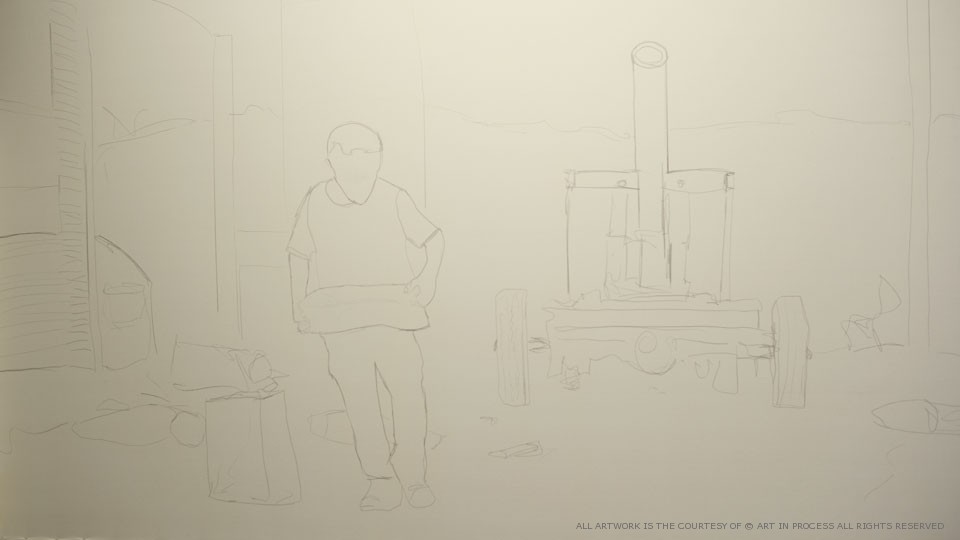installation performance and documentary video installation – artistic idea to be yet realised
an exhibition in two parts
First and active part: For a set period of time the audience finds the artist in front of a large canvas in the exhibition space.
In this work the artist recurrently wets a large canvas just with water. The audience is invited to ask him questions about the developing work and the artist tells them, how the painting may look like. The artist requires the audience to activate their own imagination, on which it depends to create a most accurate picture of the work. The artist, reacting to the audience’s questions, draws the painting in front of their mind’s eye. Like with the tale The Emperor’s New Clothes, the artist plays with the audience’s socio-culturally as well as educationally formed background and tries to activate the audience in provocative ways to react to his doings or better to his doing not much. The artist simulates the process of actually painting the canvas, while working intensely on the main composition and refinements of his chosen genre that he changes with the audience’s asked questions.
The whole action ends with the canvas remaining still plain; the wet linen dried.
Second and passive part: the artist has left the space. Photos and video that document the previously done performative process, have been developed into a documentary video installation that the audience finds now presented alongside the remaining canvas.

CANVAS 01:
innocence and war
in direct relation to CANVAS (to be placed in the room of the CANVAS performance: CANVAS 01 may be the first in a series of different sketches on large canvas, presenting critical statements on society and urgent socio-political issues)
A large canvas is covered by a sketch and remains as such. The viewer may or may not perceive it as a finished or an unfinished work.
The artist’s chosen genre depends on reacting to the war in Syria and a specific media image that the artist came across on the Internet. A press photo shows a boy, carrying something heavy in his hands. It was described as follows: Issa is ten years old, and the civil war in Syria robbed his childhood. He presents a face of the war. In this picture you see him carrying a large grenade through the weapons factory in Aleppo, Syria.
The artist wants to draw attention to what we generally like to oppress: how much do the doings of the beautiful people in their beautiful countries influence war and how do they profit from the desperation of people, who see themselves caught up in poverty, oppression and persecution? And how much are these countries involved in the doings of hate and war crime that happen elsewhere by running a business that produces and sells specifically important products needed for the creation of weapons? The artist draws on the ephemeral picture of war that we consume on a daily basis (through the media) with this seemingly hasty done sketch of a war image. War is an ever present condition in this world. There is no day without it. And while we indulge in mass consumption and other western luxury, people in other places on this planet suffer from the effects of war. Corruption and a lack of conscience make rich people richer and the poor even poorer. The image, the artist refers to in this work, presents a child that obviously doesn’t know a life without war. It shows as such just one of the devastating effects of war. Disgusted by the general ignorance of us all, who do not really care about what is going on around us, the artist chose to only sketch on the large canvas. It could be seen as a cynical portrayal of how we carelessly waste things despite our brief knowledge of exploiting machineries; how we draw large images of a pretend world and how we live shallow lives, unwilling to face the consequences of our doings; ignoring the chains of impact that are clearly linked to our lifestyle. How far have we come in pretending this world to be a glamorous place, where being slim, attractive and successful may serve us as the main aims in life!?
